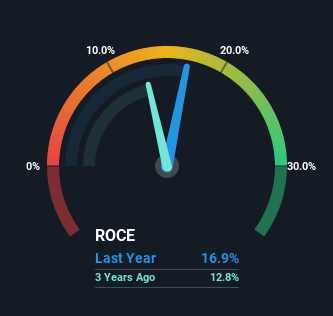Optiva (TSE:OPT) Shareholders Will Want The ROCE Trajectory To Continue
What trends should we look for it we want to identify stocks that can multiply in value over the long term? One common approach is to try and find a company with returns on capital employed (ROCE) that are increasing, in conjunction with a growing amount of capital employed. This shows us that it's a compounding machine, able to continually reinvest its earnings back into the business and generate higher returns. So on that note, Optiva (TSE:OPT) looks quite promising in regards to its trends of return on capital.
Understanding Return On Capital Employed (ROCE)
If you haven't worked with ROCE before, it measures the 'return' (pre-tax profit) a company generates from capital employed in its business. The formula for this calculation on Optiva is:
Return on Capital Employed = Earnings Before Interest and Tax (EBIT) ÷ (Total Assets - Current Liabilities)
0.17 = US$11m ÷ (US$85m - US$18m) (Based on the trailing twelve months to September 2022).
Thus, Optiva has an ROCE of 17%. In absolute terms, that's a satisfactory return, but compared to the Software industry average of 8.7% it's much better.
See our latest analysis for Optiva

Above you can see how the current ROCE for Optiva compares to its prior returns on capital, but there's only so much you can tell from the past. If you'd like, you can check out the forecasts from the analysts covering Optiva here for free.
So How Is Optiva's ROCE Trending?
It's great to see that Optiva has started to generate some pre-tax earnings from prior investments. Historically the company was generating losses but as we can see from the latest figures referenced above, they're now earning 17% on their capital employed. In regards to capital employed, Optiva is using 61% less capital than it was five years ago, which on the surface, can indicate that the business has become more efficient at generating these returns. Optiva could be selling under-performing assets since the ROCE is improving.
The Key Takeaway
In a nutshell, we're pleased to see that Optiva has been able to generate higher returns from less capital. Astute investors may have an opportunity here because the stock has declined 69% in the last five years. So researching this company further and determining whether or not these trends will continue seems justified.
If you want to know some of the risks facing Optiva we've found 3 warning signs (2 are concerning!) that you should be aware of before investing here.
While Optiva may not currently earn the highest returns, we've compiled a list of companies that currently earn more than 25% return on equity. Check out this free list here.
New: AI Stock Screener & Alerts
Our new AI Stock Screener scans the market every day to uncover opportunities.
• Dividend Powerhouses (3%+ Yield)
• Undervalued Small Caps with Insider Buying
• High growth Tech and AI Companies
Or build your own from over 50 metrics.
Have feedback on this article? Concerned about the content? Get in touch with us directly. Alternatively, email editorial-team (at) simplywallst.com.
This article by Simply Wall St is general in nature. We provide commentary based on historical data and analyst forecasts only using an unbiased methodology and our articles are not intended to be financial advice. It does not constitute a recommendation to buy or sell any stock, and does not take account of your objectives, or your financial situation. We aim to bring you long-term focused analysis driven by fundamental data. Note that our analysis may not factor in the latest price-sensitive company announcements or qualitative material. Simply Wall St has no position in any stocks mentioned.
About TSX:OPT
Optiva
Provides cloud-native monetization and business support systems products to communication service providers (CSP) in Europe, the Middle East, Africa, North America, Latin America, the Caribbean, Asia, and the Pacific Rim.
Slight risk and slightly overvalued.
Similar Companies
Market Insights
Weekly Picks

Solutions by stc: 34% Upside in Saudi's Digital Transformation Leader


The AI Infrastructure Giant Grows Into Its Valuation
Recently Updated Narratives
Many trends acting at the same time


Engineered for Stability. Positioned for Growth.


Staggered by dilution; positions for growth
Popular Narratives


MicroVision will explode future revenue by 380.37% with a vision towards success


NVDA: Expanding AI Demand Will Drive Major Data Center Investments Through 2026



